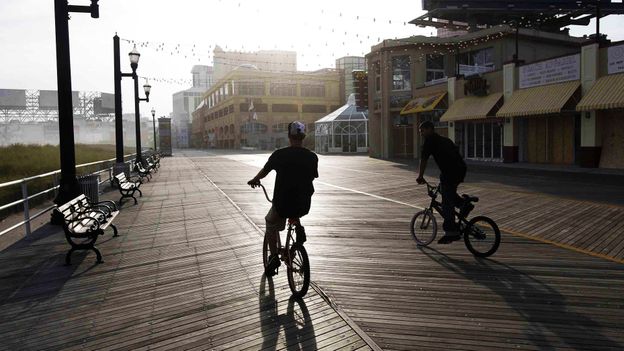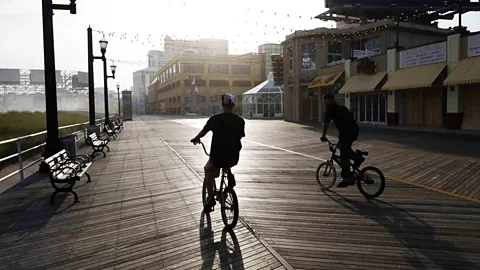Atlantic City’s fading boardwalk empire


The heyday of New Jersey’s famous resort town has passed, but traces of it can still be found.
Atlantic City is a town of contradictions and illusions. There is the get-rich-quick allure of the casinos, whose shimmering veneers obscure a slowly decaying undercoat of cigarette smoke and lost pay checks. And the iconic boardwalk stretches for miles, bordered by fast food restaurants, amusement park attractions, and tchotchke shops on one side, the sparkling ocean on the other.
HBO’s hit series Boardwalk
Empire, entering its second
season this September, has reincarnated a nostalgic vision of Atlantic City,
replete with gangsters, molls, speakeasies and poker joints. But the truth is
that very little of the old-school den of vice and pleasure remains. Atlantic
Avenue, the city’s main drag, has been reduced from a thriving artery that
pumps cars toward glitz and glamour to a haven for pawn shops, check cashers,
and outlet stores. Donald Trump and his ilk have razed classic hotels, casinos
and bars and over the past few years, tourism has declined.
“You used to see traffic stretching all the
way down Atlantic Avenue,” said a bartender at the vintage dive Culmone’s (2437
Atlantic Ave, 609-348-5170), while serving a smattering of mid-day customers
nursing their drinks. “You don’t see that anymore.” The bar, which opened in
the late 1950s, has seen better days, but it is a friendly spot away from the
hubbub of the boardwalk.
At the city’s north
end, climb the 228 steps of the Absecon Lighthouse, the tallest in New Jersey and more than 150
years old, for a stunning view of this mini metropolis. Sandy flats lie to the
east, west and south, with empty lots jutting up against halted new
construction, gambling mainstays and the crumbling inner city. To the north
lies Brigantine
Beach, just across a narrow
waterway full of boats. Farther to the south lies the more affluent community of Margate, once known as South Atlantic City, and home to some of the historical
remnants of the city’s storied past. Here visitors can find a taste of the
Atlantic City that once was.
Lucy
the Elephant towers over the
beach in Margate, six stories tall and gleaming in the sunshine. The giant
pachyderm was constructed in 1881 by James V Lafferty. Among other things, Lucy
served as a pre-Prohibition tavern, before being established as a National Historic Landmark in the 1970s. Currently there are two
restaurants in Lucy’s shadow, Bella Luna and Lucy’s Beach Grille, and festivals and fairs are occasionally held
underneath her wooden belly. Today, Lucy
is open to the public and visitors are allowed to climb to the top where they enjoy
a view of the Atlantic Ocean.
Marven Gardens,
located on the border of Margate and Ventnor City, is an interesting and
affluent neighbourhood of historic houses with architecture dating back to the
1920s and ’30s. It is bordered by four avenues: Brunswick, Fredericksburg,
Ventnor and Winchester. The Marvin Gardens property of the Monopoly board game
was named after the area but misspelled, which Parker Brothers officially
apologized for in 1995. Marven Gardens is listed on the National Register of Historic
Places.
Head north into
Atlantic City proper and the experience is quite different from the almost
bucolic feel of Margate and Marven Gardens. The boardwalk is the obvious draw,
a tourist attraction stretching about four miles along the coast with a diverse
mass of humanity — rich and poor, young and old, black and white, families and
miscreants — tromping up and down the wooden slats. On my recent visit a
one-armed man shouted nonsense at the top of his lungs and lurched past
tourists who were looking for a bite to eat. Over on the side of the boardwalk,
a street preacher foretold the end of days while teenage girls in bikinis and
boys on bikes flirted and laughed. A Hare Krishna festival’s enthusiastic
practitioners pushed a float by an outdoor discotheque with house music
pumping. Dichotomies and illusions abound.
The Steel Pier, located across from Trump Taj Mahal, opened in 1898 and has been a centre of
Atlantic City entertainment ever since. Once home to circus performers and the
Miss America Pageant, the Pier is now a modernamusement park of rides and
attractions, including the thrilling Rocket that slingshots riders 225 feet
into the air, and a variety of fried foods. Boardwalk Hall, formerly known as Convention Hall, is another
unofficial historic landmark along the boardwalk. Built in 1929, it has hosted
sporting events and concerts throughout the years, including the first indoor college
football game in 1930 and indoor helicopter flight in 1970. It was overhauled
in 1998 and is now a modern facility for concerts and boxing matches.
Many casinos and
hotels line the Boardwalk, including the Tropicana, Atlantic
City Hilton and Showboat
Atlantic City. All of these
offer a huge array of accommodations, restaurants and gambling options, but
none retain much of the old Atlantic City flavour. Much like Las Vegas, this is
a fully modernized version of the past (though Atlantic City is more like the
area a few blocks off the Vegas Strip). For those who prefer to stay in a
non-gambling hotel on the Boardwalk, the Chelsea does its best to capture a 1950s retro vibe with modern trimmings. On a
summer weekend, rooms are not cheap, starting at $450 a night for double
occupancy. On Saturday nights, the Chelsea turns into something of a party
hotel, with festivities taking place at the fifth floor outdoor pool area until
the wee hours of the morning. Guests do not have to pay the $20 entrance fee,
but the party is more Jersey Shore
than Boardwalk Empire, with
guys and girls in their early twenties drinking and grinding to throbbing
techno music. The hotel has an upscale steakhouse called Chelsea Prime and a good casual diner, Teplitzky’s, open for breakfast, lunch, dinner and
after-hours drinks.
Although Atlantic City
has been thoroughly modernized, sacrificing much of its vibrant, edgy character
in the process, it is still possible to seek out some scattered ghosts of the
past. A block or two off the boardwalk on St James Place sits the darkened
interior of the
Irish Pub. It opened in 1972,
but the pub has the vintage feel of the speakeasy the space once held. The
dimly lit bar is a perfect spot to get away from the heat and commotion of the boardwalk,
throw back a pint and check out the memorabilia lining the walls. The menu
consists of typical pub grub with a few Irish specialties like corned beef
thrown in for good measure.
For a more elegant
dining experience, and a real taste of historic Atlantic City, the Knife & Fork Inn is the place. Since 1912 this distinct
building located a few blocks off the boardwalk has famously played host to
politicians, entertainers and their cronies. According to its website, during
Prohibition the Knife & Fork flouted federal law while the real-life
“Nucky” Thompson held court at its bar. Frank Sinatra and Bob Hope were said to
be regulars in their heyday as well. The restaurant underwent a major
renovation in 2005 and there are now three floors of different dining rooms, an
enormous wine selection and a comforting menu of surf and turf featuring their
famous dish, lobster Thermidor. The owners also operate Dock’s Oyster House, another classic Atlantic City bar and
restaurant that dates back to 1897.
So what is the truth
behind Atlantic City’s illusions? Is this a city destined for rejuvenation or
further deterioration? For its businesses and residents, things may be getting
better. According to a recent article in the Philadelphia
Inquirer, tourism has been on
the upswing this year, thanks in part to the early and sustained summer heat
blanketing the Eastern seaboard. The success of Boardwalk Empire has also inspired new visitors, and casinos and
restaurants are capitalizing on this by offering special dining and lodging
promotions. But for the most part, vintage Atlantic City is a memory, a ghost.
Source link



